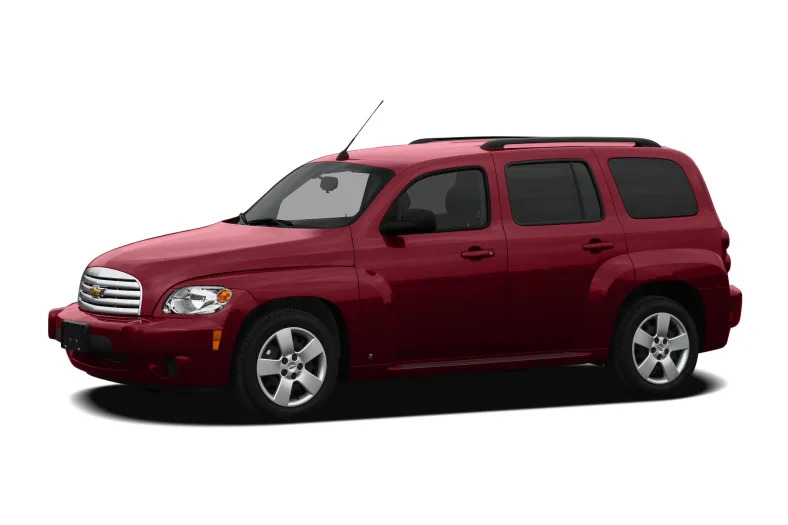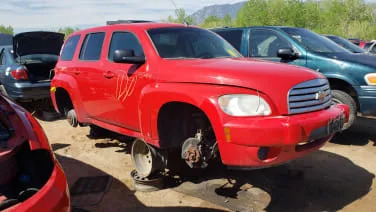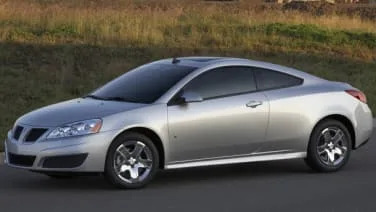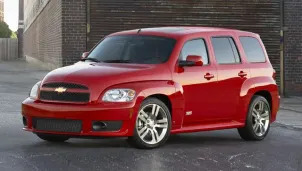2008 Chevrolet HHR
The General has been on a roll as of late with new vehicles like the Saturn Aura, Cadillac CTS, Chevy Malibu and its line of redesigned trucks and SUVs that have been garnering good reviews and the attention of customers. We were invited to test drive the new Chevrolet HHR SS to see if they've knocked one out of the park, hit a foul or, ahem, missed the ball completely when transforming the little retro-mobile into a Super Sport. Our driving and vehicle impressions can be found after the jump, but for starters, remember these two key phrases: launch control and no-lift shifting. Intrigued? We were. %Gallery-11798% We'll get back to the techno-goodies baked into the HHR SS package soon, but first, maybe we can take some time to do a proper walk-around. The HHR has been around for a few years now, so you've likely already drawn a conclusion on its retro styling. There are some changes with the SS, but the car is still instantly recognizable as a Morris Minor Heritage High Roof. The front has been dropped a bit, and the wheels fill up the bulbous fenders much nicer with the SS package's 18-inch rims. They're shod with fairly sticky Michelin Pilot Sport tires at P225/45R18. We like the new aero-package as a whole, but are much more impressed by what's under the hood. Sporting the same Direct-Injected 2.0 liter four-cylinder as the Solstice GXP and Saturn Sky Redline, the HHR packs an impressive 130 horsepower per liter. Multiply that by 2 and you arrive at the full 260 horsepower that's available with the manual transmission. The automatic loses out on power by a few dozen horses and offers a more sedate driving experience. We'd suggest you stick to the manual so you don't miss out on the awesomeness that is the launch control and no-lift shifting. Here's how it works. Put the car into "Competitive Mode" by hitting the stability control button twice. Come to a stop. Floor the throttle. Release the clutch. Next up is the no-lift shift to second. You'll likely never tire of holding the go-pedal to the floor and slamming the shifter into the next gear. Reward yourself by keeping the engine at full power with no loss of boost pressure by no-lift shifting into third and you'll be staring at triple-digits on the speedometer. Hold off the throttle pedal a bit and you'll be able to get near 30 miles per gallon on the highway, according to the EPA. Keep an eye on the boost gauge, which has been added (seemingly rather hastily) to the driver-side A pillar. Depending on your choice of color, consider the red or our favorite, the silver interior schemes. The FE5 suspension that comes standard in the SS model strikes us as a good balance between the necessary freeway drones we all are forced to contend with and the twisty backroads that we all love to play with. The go-fast crew at GM played around …
Full Review
The General has been on a roll as of late with new vehicles like the Saturn Aura, Cadillac CTS, Chevy Malibu and its line of redesigned trucks and SUVs that have been garnering good reviews and the attention of customers. We were invited to test drive the new Chevrolet HHR SS to see if they've knocked one out of the park, hit a foul or, ahem, missed the ball completely when transforming the little retro-mobile into a Super Sport. Our driving and vehicle impressions can be found after the jump, but for starters, remember these two key phrases: launch control and no-lift shifting. Intrigued? We were. %Gallery-11798% We'll get back to the techno-goodies baked into the HHR SS package soon, but first, maybe we can take some time to do a proper walk-around. The HHR has been around for a few years now, so you've likely already drawn a conclusion on its retro styling. There are some changes with the SS, but the car is still instantly recognizable as a Morris Minor Heritage High Roof. The front has been dropped a bit, and the wheels fill up the bulbous fenders much nicer with the SS package's 18-inch rims. They're shod with fairly sticky Michelin Pilot Sport tires at P225/45R18. We like the new aero-package as a whole, but are much more impressed by what's under the hood. Sporting the same Direct-Injected 2.0 liter four-cylinder as the Solstice GXP and Saturn Sky Redline, the HHR packs an impressive 130 horsepower per liter. Multiply that by 2 and you arrive at the full 260 horsepower that's available with the manual transmission. The automatic loses out on power by a few dozen horses and offers a more sedate driving experience. We'd suggest you stick to the manual so you don't miss out on the awesomeness that is the launch control and no-lift shifting. Here's how it works. Put the car into "Competitive Mode" by hitting the stability control button twice. Come to a stop. Floor the throttle. Release the clutch. Next up is the no-lift shift to second. You'll likely never tire of holding the go-pedal to the floor and slamming the shifter into the next gear. Reward yourself by keeping the engine at full power with no loss of boost pressure by no-lift shifting into third and you'll be staring at triple-digits on the speedometer. Hold off the throttle pedal a bit and you'll be able to get near 30 miles per gallon on the highway, according to the EPA. Keep an eye on the boost gauge, which has been added (seemingly rather hastily) to the driver-side A pillar. Depending on your choice of color, consider the red or our favorite, the silver interior schemes. The FE5 suspension that comes standard in the SS model strikes us as a good balance between the necessary freeway drones we all are forced to contend with and the twisty backroads that we all love to play with. The go-fast crew at GM played around …
Hide Full Review
Hide Full Review
Retail Price
$16,730 - $22,925
MSRP / Window Sticker Price
| Engine | 2.0L I-4, 2.2L I-4 |
| MPG | Up to 21 city / 30 highway |
| Seating | 5 Passengers |
| Transmission | 5-spd man w/OD |
| Power | 149 - 260 hp |
| Drivetrain | front-wheel |
| Curb Weight | 3,155 - 3,280 lbs |
Smart Buy Program is powered by 






